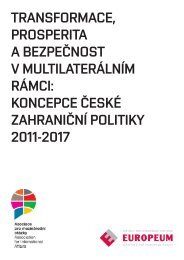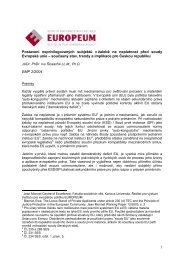eu constitutionalisation - EUROPEUM Institute for European Policy
eu constitutionalisation - EUROPEUM Institute for European Policy
eu constitutionalisation - EUROPEUM Institute for European Policy
You also want an ePaper? Increase the reach of your titles
YUMPU automatically turns print PDFs into web optimized ePapers that Google loves.
meetings, the presidency prepared its final papers <strong>for</strong> the <strong>European</strong> Council,the final arena in which agreement would or would not be achieved.The member states were given two papers, the open and closed documents,immediately prior to the <strong>European</strong> Council meeting. The closeddocument (CIG 81/04) had 57 annexes representing broad agreementon the text contained in that presidency paper. The open document wasa discussion document designed to structure the debate on the outstandinginstitutional and non-institutional issues. Concerning the institutionalissues, the presidency outlined its thinking on QMV, seats in the EP andmade specific proposals on the composition of the Commission. The paperalso dealt with a number of non-institutional issues relating to economicgovernance, the multi-annual financial framework and the legal status ofthe Charter as part of the constitutional treaty.Following discussion on 17 June, the presidency made further proposals on 18June in a document containing 14 annexes, which represented the outstandingissues in the negotiations. Following intense bilateral discussions, the<strong>European</strong> Council agreed the final text on the evening of the last day of thesummit. The key break through was agreement on the institutional package,the Commission, definition of qualified majority voting, seats in the EP and theimplementation rules of the new system of QMV. The strategy of the presidencywas to accumulate agreement by establishing a closed document, to reducethe number outstanding issues to a minimum <strong>for</strong> the <strong>European</strong> Council andto search <strong>for</strong> an ‘overall and balanced agreement’.⁴² The documents preparedby the presidency are replete with references to ‘balance among all MemberStates’ and an ‘overall balanced outcome on the institutions’.⁴³The Irish Presidency: Analysis of Bargaining StrategyThere are some striking features of the above overview of the bargainingprocess. Firstly, the key approach adopted by the Irish presidency was toreach agreement on as many issues as possible be<strong>for</strong>e the culmination ofthe IGC. Where possible, individual states were left to attempt to reachtheir own compromise. However, if it became apparent that they were notsucceeding, the Irish presidency stepped in (<strong>for</strong> example, the taxation issuedebated by French, British and German leaders). The intervention by Bertie42) CIG, 84/94, 143) CIG 82/04, 2Chapter 3: The 2004 IGC: Bargaining or Learning?Chapter 3: The 2004 IGC: Bargaining or Learning?Ahern and his civil servants and the strong personal rapport developedby Ahern through his tour of <strong>European</strong> capitals appeared to contributeto successful Irish management of the IGC. By 14 June there was nearlya complete consensus on all the bargaining issues.Secondly, a striking feature of the Irish presidency is the decision to seekthe satisfaction of Franco-German preferences, where these two statesagreed. This Irish decision meant that Irish preferences with respect tospecific issues, <strong>for</strong> example, membership of the Commission and other‘small-state’ issues were not advanced by an Irish presidency. An agreementwas reached administratively that the EU division of Irish Department ofForeign Affairs would have autonomy from other civil service departmentsin negotiations – other key civil departments, <strong>for</strong> example, the Departmentof Finance would not intervene. There<strong>for</strong>e, internal turf wars and attemptsto achieve departmental interests did not undermine coherence. While thisapproach implied an admirable setting aside of individual Irish interests,it also reflected the influence of more powerful actors in the bargainingprocess. The rational institutionalist hypothesis that institutions enablesmall states to influence outcomes is thus undermined.However, qualifying the above conclusion, where a small or medium-sizedstate concentrated resources on an issue of key national importance, theIrish presidency did engage strongly with that particular issue and generally,the specific state achieved its aims, if the issues were not central to largestates’ bargaining agenda. Indeed, such a scenario was outlined in the earlyinstitutionalist examinations of state bargaining.Also qualifying the above hypothesis, the bargaining style adopted resembledone of ‘problem-solving’ rather than simple bargaining, implying the existenceof consensual knowledge. Awareness of a need to work together in thefuture and needing future agreements ensured that all members sought toadopt a consensual approach to current bargaining problems – the ‘shadowof the future’. This regime facilitated co-operation. Moreover, from the case ofthe Irish presidency there appears to be evidence that working together overtime created psychological co-operative norms of behaviour.⁴⁴ For example,the Austrian government was willing to aid Irish endeavours to reach agreementbecause it remembered that the Irish government had not supported44) ELGSTROM and JONSSON (2000), p. 68892 93








